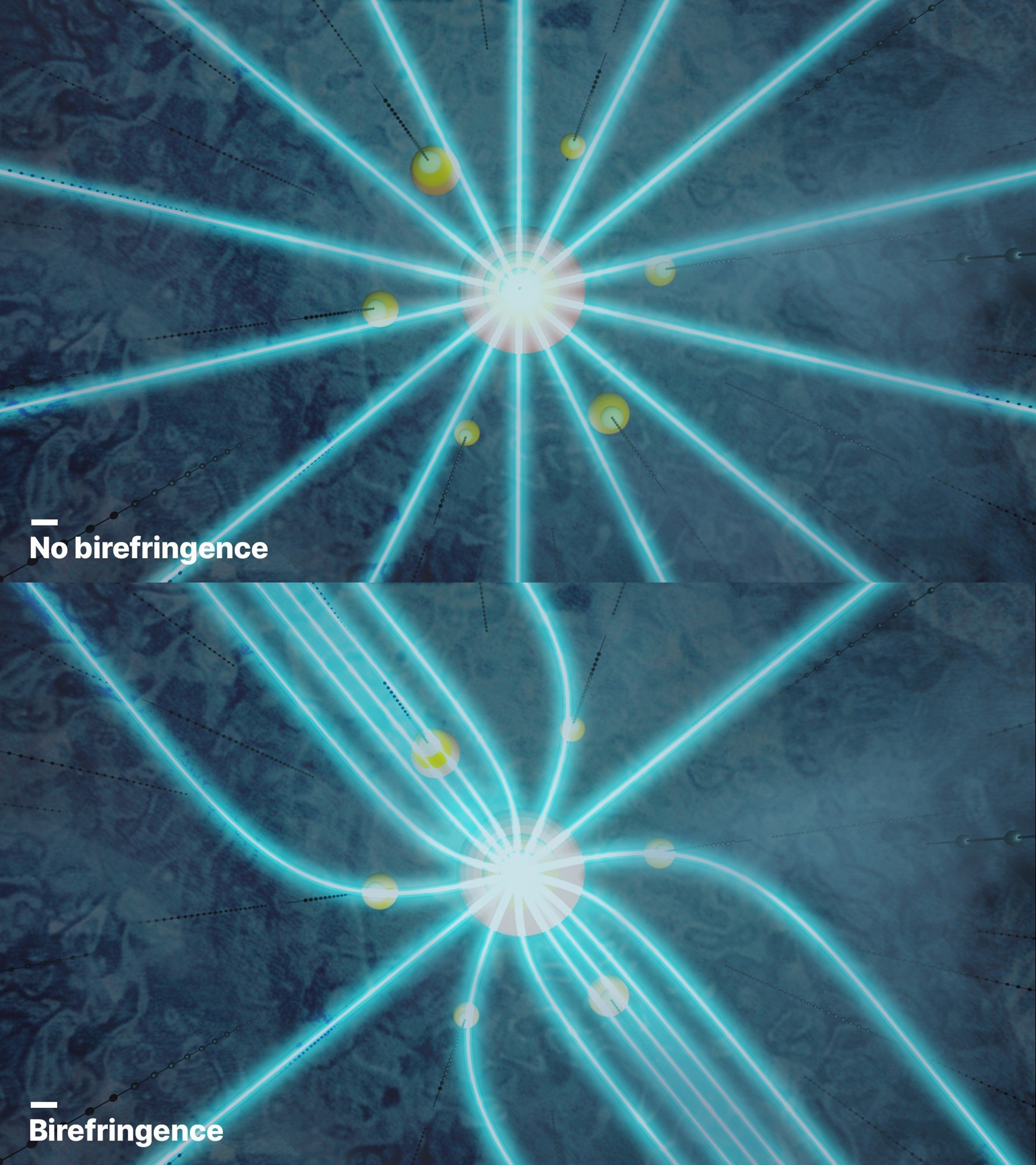Reviewed by Mila PereraOct 25 2022
Using IceCube, a team of scientists has succeeded in seeing through the Antarctic diffuse ice.

Illustration visualizing the newly discovered optical effect: Without birefringence (top), light streams out radially from an isotropic light source. With birefringence (bottom), the light gets slowly deflected toward the ice flow axis. Image Credit: Jack Pairin/IceCube Collaboration
Approximately 100 trillion neutrinos travel through the human body every second. These minute, nearly massless particles travel great distances through space while transporting data about their sources and are formed by some of the universe’s most energetic phenomena. However, neutrinos are extremely hard to detect, necessitating a dedicated detector that can “see” these virtually invisible particles.
The IceCube Neutrino Observatory, situated at the South Pole, was completed on December 18th, 2010. Developed to locate high-energy cosmic neutrinos, the detector comprises a group of 5,160 optical sensors, known as digital optical modules (DOMs), buried in a cubic kilometer of Antarctic ice.
When a neutrino interacts with a molecule in the ice, blue light is released from the resulting secondary charged particles via a process known as Cherenkov radiation.
The light then moves through the ice and may reach some of the DOMs, where it is identified. Scientists can then rebuild the energy and direction of the particle, a process that depends on understanding the optical features of the ice.
In 2013, the IceCube Collaboration described a unique observation where the observed brightness of a light source depended on the direction of the light, an effect called ice optical anisotropy.
Thus far, scientists have tried to define the anisotropy with variations to impurity-induced absorption and scattering to limited avail.
In a recent study submitted to The Cryosphere, IceCube reports an optical effect that has never been described before. The effect is caused by the birefringent properties of the elongated ice crystals that deflect light in two directions.
The new insight gained was combined in a new birefringence-based ice optical model used in a detector simulation, SpiceBFR, that has considerably enhanced the interpretation of the light patterns resulting from particle interactions in the ice.
“The ice optical model in use by the IceCube Collaboration has been in development since the early days of the predecessor experiment AMANDA,” said Dmitry Chirkin, an Associate Scientist at the University of Wisconsin-Madison.
For over 20 years, we have been adding bits of discovery to our understanding of the ice, including the disappearance of trapped air bubbles at depths well above the detector and that, at deeper depths, the South Pole ice sheet contains the cleanest ice on the planet. Another discovery is the optical ice anisotropy, which is the main subject of the study that was motivated by the new understanding in our paper.
Dmitry Chirkin, Associate Scientist, University of Wisconsin-Madison
To enhance earlier attempts to describe the anisotropy, the collaborators closely examined the anisotropy effect, discovering a link between the depth development of ice crystal features and the anisotropy effect.
This led the team to believe that the many randomly assorted small crystals that constitute the ice were at work in the observed anisotropy.
Things really got rolling when we realized that curved photon trajectories with tiny, subdegree per meter deflections would be able to accurately describe the data Indeed, when calculating and simulating the light diffusion through polycrystalline ice as present in IceCube, where crystals are on average elongated along the ice flow direction, a mean deflection arises.
Dr. Martin Rongen, Study Lead and Researcher, Johannes Gutenberg University Mainz
For the study, scientists ran simulations that modeled various paths the light could travel inside the detector. They then compared replicated data with a large calibration dataset procured from IceCube.
The IceCube calibration data set contains data from 60,000 LEDs, equipped with all of the DOMs, that discharge consistent light pulses into the ice, which are then used to calibrate the optical properties of the ice.
From the comparison, scientists could deduce the mean shape and size of ice crystals inside IceCube.
This stimulating discovery triggers the creation of new simulations and the adaptation of existing reconstruction approaches to account for the SpiceBFR model.
Not only will this new insight help IceCube to enhance reconstructed neutrino interactions, but it also has inferences for the field of glaciology as a whole.
Ice crystal properties are studied in particular to understand ice flow mechanics, which can then be used to predict the Antarctic mass balance and resulting sea-level rise in a changing climate.
Dr. Martin Rongen, Study Lead and Researcher, Johannes Gutenberg University Mainz
Journal Reference
Abbasi, R., et al. (2022) In-situ estimation of ice crystal properties at the South Pole using LED calibration data from the IceCube Neutrino Observatory. The Cryosphere Discussions. doi.org/10.5194/tc-2022-174.